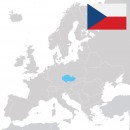A Brief Overview of the Czech Language
 Czech is certainly not a well-known or widely spoken language, but more and more people have been discovering the beauty (and advantages) of our charming, Central European country. Whether you work here, study at one of the Czech universities, or are getting ready to start a business here, learning the basics of Czech will greatly benefit you. And not just for practical reasons. For example, using a few Czech phrases while grocery shopping or at the movies will not only help you get by, but it will also make you appear more friendly, open, and approachable to locals—which leads to new friendships, or even love!
Czech is certainly not a well-known or widely spoken language, but more and more people have been discovering the beauty (and advantages) of our charming, Central European country. Whether you work here, study at one of the Czech universities, or are getting ready to start a business here, learning the basics of Czech will greatly benefit you. And not just for practical reasons. For example, using a few Czech phrases while grocery shopping or at the movies will not only help you get by, but it will also make you appear more friendly, open, and approachable to locals—which leads to new friendships, or even love!
Bridge the language gap, broaden your horizons, and start learning Czech! It’s super-easy with CzechClass101.
Before we start: Czech belongs to the West Slavic group of languages, making it very similar to Slovak, Polish, and Croatian. If you know or have learned any of these, Czech will be a piece of cake for you.
Don’t know what to expect at all? Let me walk you through some of the Czech language basics, specifics, and quirks.
Czech Language Facts and Stats
Czech is the official language of the Czech Republic, and it’s spoken by about 96% of the population. Czech is the mother tongue of about twelve million people, most of whom live in the Czech Republic (while around one million Czech speakers live abroad).
As mentioned earlier, it’s a West Slavic language and very similar to the Slovak language. For many people, especially for the older generation who watched a lot of Slovak TV back in the times of Czechoslovakia (before 1993), both languages are mutually intelligible.
Standard Czech
This is the prestigious form of the Czech language that you’ll find used in books, documents, official circumstances, and professional lectures.
You won’t hear a lot of standard Czech while roaming around the country though, and you don’t have to speak like that either. Nevertheless, as a foreigner, you’ll be taught standard Czech; so it makes sense that you would want to speak standard Czech, too. Don’t worry about accents and dialects. If you don’t understand, just ask again.
Standard Czech is codified (captured and normalized) in the rules of Czech grammar and in dictionaries (such as the Dictionary of Standard Czech Language for Schools and the Public, Dictionary of Standard Czech, etc.).
Dialects
 Spoken Czech, just like any other language, has many different forms that vary regionally.
Spoken Czech, just like any other language, has many different forms that vary regionally.
For example, there’s a vast difference between the Bohemian and Moravian Czech that you’ll notice right away.
Please note that the differences between Czech language dialects only occur in spoken form. Here are some common dialect groups:
- Czech dialectal group (with common Czech as an inter-dialect)
- Central Moravian dialectal group (Hanakian)
- East Moravian dialect group (Moravian-Slovak)
- Silesian dialects (Lachian)
Example:
Standard Czech: vozík (”cart”)
- Vozejk
- Vozék
- Vozík
- Vozik
Dialects in Czech are kind of like the differences between British and American English. The grammar is always consistent, but the spoken form sounds different and uses different words for the same things.
As a native Czech speaker, I can say that, for example, the Prague and Silesian dialects sound like two completely different languages. Shrug.
What Does it Sound Like? Phonology.
Czech is a little on the tougher side when it comes to phonology and pronunciation.
To understand how it works, check out our Czech language pronunciation guide. It’s a great overview with helpful info and details about the Czech alphabet and sounds.
But for now:
- In Czech, words are pronounced just like they’re written.
- You always put the stress on the first syllable of a word.
- In Czech, there are also words that do not have vowels at all. (krk - “neck” / prst - “finger”)
Consonants
The consonants are divided into four categories:
- Hard – rough sound (h, ch, k, r, d, t, g, n)
- Soft – gentle sound (š, č, ř, ž, ď, ť, ň)
- Ambivalent – either soft or hard, depending on the circumstances (b, f, l, m, p, s, v, z)
- Unusual – only used in foreign words like komplexní (”complex”) [q, w, x]
Vowels
There are long and short vowels in the Czech language. Long vowels have to be pronounced noticeably longer than the short ones, and they’re indicated by a long mark (čárka) placed above the letter.
- Short vowels (a, e, i, y, o, u)
- Long vowels (á, é, í, ý, ó, ů, ú)
Vocabulary
There are some basic words and phrases you might want to start with as you build your Czech language vocabulary. Starting with words and phrases you’ll use daily is a practical way to slowly build up your vocabulary.
Basic Greetings
- Dobrý den (”Good day”) - can be used anytime during the day in formal-ish settings
- Ahoj (”Hello” or “Bye”) - the most widely used informal Czech greeting
- Nashledanou (”Goodbye”)
Please note that we don’t greet people with Jak se máš? (”How are you”). Only ask this question if you really mean it.
Here’s how to introduce yourself:
- Jmenuji se ___. (”My name is ___.”)
- Já jsem ___. (”I am ___.”)
Make sure you go through our introduction guide here.
Niceties
- Těší mě. (”Nice to meet you.”)
- Dlouho jsme se neviděli. (”Long time no see.”)
- S dovolením. (”Excuse me.”)
- Děkuji. (”Thank you.”)
This vocabulary list will help you learn all you need to get started with Czech. Also, don’t miss this list of 100 core Czech words!

Czech Writing System
Written Czech uses the Latin alphabet (just like English), though Czech also uses specific diacritics in its writing system. Czech consists of twenty-six Latin letters (the same as those in English) plus letters with these special diacritic accents.
- The alphabet includes forty-two characters.
There are three types of accents:
- the acute accent čárka (length mark) for indicating the length of vowels
- the háček (hook) for changing sound
- the kroužek (circle) for indicating the long pronunciation of the letter u (only ů).
You can find a Czech language alphabet chart with examples and pronunciation on our website.
Learning the alphabet first might feel unnecessary, but it’s actually important. Don’t skip this step. Learning the basics of the alphabet will help you start recognizing simple Czech words, which will keep you motivated!
Czech Grammar
You’ll learn that Czech grammar and English grammar are very different.
- The Czech language word order is much looser and based on context.
- Each noun and adjective has fourteen different forms (seven for singular and seven for plural), which is called declension.
- Verbs are conjugated.
- There are three genders: feminine, masculine (animate and inanimate), and neuter.

Czech Word Order
The Czech sentence structure is SVO (subject-verb-object).
However, this can vary depending on the message being conveyed.
- Rule of thumb: The most important information usually goes last.
For example:
- Včera byl spuštěn (V) nový program (S). – “A new program was launched yesterday.”
- The focus here is on what was launched.
- Ten nový program (S) byl spuštěn (V) včera. – “The new program was launched yesterday.”
- The focus here is on when it was launched.
- Je (V) to úplná novinka (S). – “It is a novelty.”
- Here, the most important information is what it is.
Null-subject sentence:
Czech is a null-subject language, which means that the subject (including personal pronouns) can be omitted if it’s known from the context.
- Mám (V) dva domy (O). – “I have two houses.” [Null S-V-O]
- Mají (V) na to jiný názor (O). – “They have a different opinion.” [Null S-V-O]
- Máme (V) rádi zvířata (O). – “We love animals.” [Null S-V-O]
Questions:
Again, the word order is very loose and questions are mainly indicated by intonation and, in written form, with a question mark.
The standard word order for questions is V-S-O.
- Eva (S) nemá (V) velký dům (O). – “Eva doesn’t have a big house.”
- Eva (S) nemá (V) velký dům (O)? – “Eva doesn’t have a big house?” (”I thought she did!”)
- Nemá Eva velký dům? – “Doesn’t Eva have a big house?” (”Some of our guests can stay over at her place!”)
Declension
Declension is a (mind-blowing) system of grammatically determined modifications for nouns, adjectives, pronouns, and numerals. Nouns are declined according to paradigms.
Czech has seven cases: nominative, genitive, dative, accusative, vocative, locative, and instrumental.
Pronoun declension is a bit more complicated: some of them are declined according to adjective paradigms, and some are irregular.
Here’s an example of Czech language declensions:
| Case | Feminine, singular | Masculine, singular, animate | Masculine, singular, inanimate | Neuter, singular |
|---|---|---|---|---|
|
1. |
Kniha (”book”) |
Pes (”dog”) |
Hrad (”castle”) |
Kuře (”chicken”) |
|
2. |
Knihy |
Psa |
Hradu |
Kuřete |
|
3. |
Knize |
Psovi |
Hradu |
Kuřeti |
|
4 |
Knihu |
Psa |
Hrad |
Kuře |
|
5. |
Kniho |
Pse |
Hrade |
Kuře |
|
6. |
Knize |
Psovi |
Hradě |
Kuřeti |
|
7. |
Knihou |
Psem |
Hradem |
Kuřetem |
| Case | Feminine, plural | Masculine, plural, animate | Masculine, plural, inanimate | Neuter, plural |
|---|---|---|---|---|
|
1. |
Kniha (”books”) |
Psi (”dogs”) |
Hrady (”castles”) |
Kuřata (”chickens”)) |
|
2. |
Knih |
Psů |
Hradů |
Kuřat |
|
3. |
Knihám |
Psům |
Hradům |
Kuřatům |
|
4 |
Knih |
Psy |
Hrady |
Kuřata |
|
5. |
Knihy |
Psi |
Hrady |
Kuřata |
|
6. |
Knihách |
Psech |
Hradech |
Kuřatech |
|
7. |
Knihami |
Psi |
Hrady |
Kuřaty |
Czech Language History and Cultural Background
The Czech language evolved from its West Slavic roots near the end of the first millennium. The oldest stage of Czech as a separate language started at the end of the tenth century. The first literal evidence of its existence can be traced back to the twelfth or thirteenth century, when the letters of the Latin alphabet were used.
In the Middle Ages, Czech started to expand and develop over time to include written Czech as a literary means. Czech extended to even more countries, following the expansion of the Bohemian state.
The twentieth century saw spoken Czech find its way into numerous genres in the literary world, and since then, the Czech language has become more and more influential throughout the world due to its variety of media.
Since May 2004, Czech has been one of the 23 official languages of the European Union.
How CzechClass101.com Helps You Learn Czech in a Fun Way
 CzechClass101.com makes learning Czech easy, exciting, and fun. With us, it’s not about endless memorizing or thick textbooks. Learn Czech with us and make progress faster than you could imagine!
CzechClass101.com makes learning Czech easy, exciting, and fun. With us, it’s not about endless memorizing or thick textbooks. Learn Czech with us and make progress faster than you could imagine!
What can you find here?
- English-to-Czech translation and pronunciation tips/tricks
- Over 630 audio and video lessons
- Vocabulary learning tools
- Spaced repetition flashcards
- Detailed PDF lesson notes
Sign up now—it’s free!


